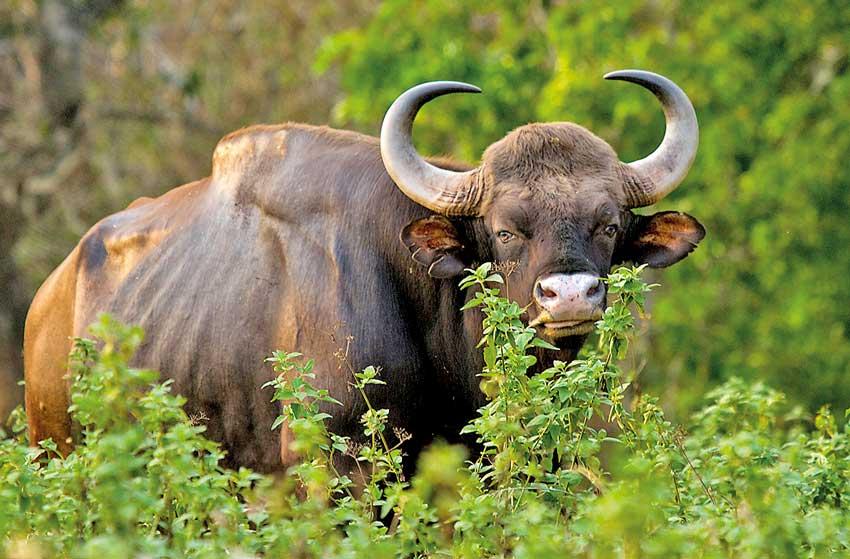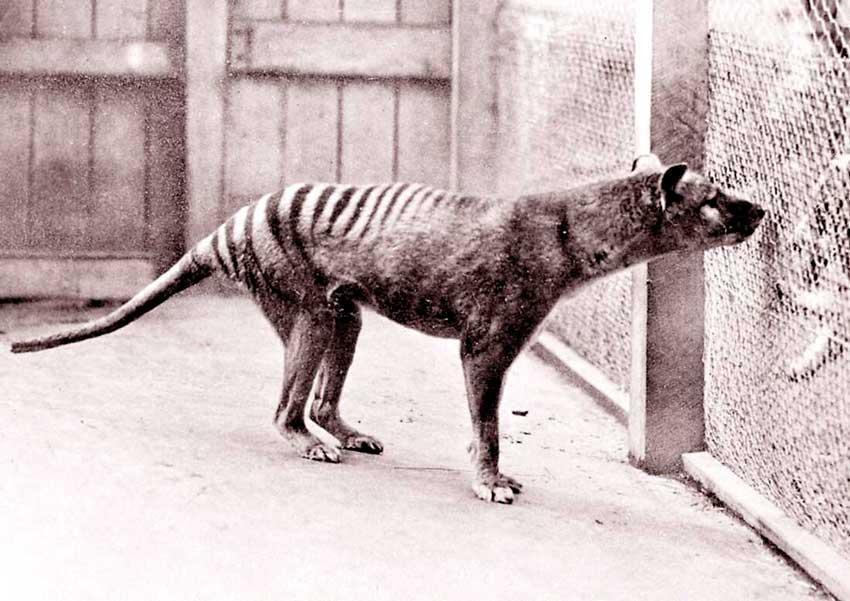06 Oct 2022 - {{hitsCtrl.values.hits}}

Indian Gaur

Tasmanian Tiger
 What do the Cheetah, the Indian bison and the Tasmanian Tiger have in common? Efforts to either save them or bring them back from extinction.
What do the Cheetah, the Indian bison and the Tasmanian Tiger have in common? Efforts to either save them or bring them back from extinction.
Sri Lanka recently proposed to the Indian government to assist the island nation by providing six specimens of the ‘Gaur’ - a bull, and three to five cows for captive breeding over a five-year period. The Gaur, also known as the Indian bison, is a bovine native to South Asia and Southeast Asia, and has been listed as vulnerable on the IUCN Red List since 1986.
Sri Lanka is presently seeking six gaurs, or Indian bison, from India as part of a proposal to reintroduce the animal to the country, where it is believed to have gone extinct sometime during the 17th Century. Sri Lanka has reportedly made this proposal to India’s External Affairs Ministry, following an Indian partnership with Namibia to reintroduce cheetahs into the wild in Madhya Pradesh.
The Gaur, whose scientific name is ‘bos gaurus’, is the largest of the world’s species of wild cattle. It has been listed as vulnerable on the ‘red list of threatened species’ by the International Union for Conservation of Nature (IUCN) since 1986. The gaur is believed to have ranged widely in Sri Lanka from at least 30,000 years ago. The last recorded gaur in Sri Lanka was part of the menagerie of King Rajasinghe II of Kandy in the late 17th Century. The IUCN Red List details some 21 extinct species in Sri Lanka, including amphibians, birds, fish, mammals, reptiles and vascular plants. However, this is not an exhaustive list and is not representative of all species in the country, as only a certain number of species have been assessed for the Red List. Asked of any discussions or efforts on reviving extinct species of Sri Lanka, the Director General at Department of Wildlife Conservation, Chandana Sooriyabandara said that so far there are no plans to bring back extinct animals as it is not their mandate.
Why restore extinct species?
Animal populations that have completely or partially disappeared from the wild can be reestablished in captivity or through relocation. Reintroducing extinct in the wild animals to their original ranges can benefit both the animals’ population growth and the restoration of damaged ecosystems. However, releasing a species into the wild is a delicate balancing act.
Recent developments and scientific advances have increased the potential for cloning extinct and endangered species. Yet, these methods of cloning have specific ethical considerations that set them apart from regularly used cloning techniques. For instance, cloning of the Cheetah (and other fragile or endangered species) may be morally acceptable under specific conditions.
The ethics of cloning extinct species, however, vary; for instance, cloning mammoths and Neanderthals is more challenging from an ethical standpoint than conservation cloning and calls for more consideration. Neanderthal cloning in particular is debated to border on the unethical side, with many believing such studies should not even be initiated. The limitations required to lessen the negative effects of conservation and extinct cloning must be discussed and planned for, and it is essential that public and scientific dialogue inform and direct initiatives in this area.
The Tasmanian Tiger
“We would strongly advocate that first and foremost we need to protect our biodiversity from further extinctions, but unfortunately we are not seeing a slowing down in species loss,” said Andrew Pask, a professor at the University of Melbourne and head of its Thylacine Integrated Genetic Restoration Research Lab, who is leading the initiative.
The “Thylacine” better known as the “Tasmanian Tiger” which was wiped out many decades ago is trying to return with human help this time. The Thylacine is an extinct carnivorous marsupial that lived in Australia and Tasmania.
This marsupial went extinct in 1936 after the last surviving Thylacine died that year. Before moving on to the story of resurrection, here is to knowing the survival story of the Thylacine. The thylacine was at the height from 100cm - 130cm with a stiff long tail which smoothly extended from the body in a way similar to that of a kangaroo. It had relatively short legs and had a powerful jaw which opened up to 80 - 90 degrees but the jaw bones were light and weak enough to bear large prey. Its popular nickname “Tiger” was named for the 15 - 20 peculiar black stripes featured over its yellow-brown coat. As the Europians discovered the animal in the island of Tasmania they called it the “Tasmanian Tiger”. Another identical feature is that both male and female Thylacines had a pouch.
The Australian Museum states that this carnivorous marsupial is known to have mostly preyed on birds and sheep. Yet many researches state, the tiger-like hunter preyed on wallabies, bandicoots, possums and small other animals and flightless birds. It was a specialised eater that preferred soft body tissue such as the liver, kidneys, heart and lungs, and soft flesh. Since 1803, the European settlers who moved to Australia introduced many domestic animals such as poultry, sheep and rabbits on which the Thylacine may have occasionally preyed on. Thylacines originally belonged to the eucalyptus forests, wetlands and grasslands of Mainland Australia and woodlands and coastal heaths in Tasmania. Records were found of the marsupial having sheltered in New Guinea. It appears to have kept to its home range without being territorial; groups too large to be a family unit were sometimes observed together. A 2011 study by the university New South Wales stated that feeble jaws of the hunter made it hunt creatures only of its own size.
The end of the Tasmanian Tiger
Reliable accounts state that the population growth and arrival of Dingoes occurred 5000 years ago, were the main causes for the Thylacine reaching extinction in mainland Australia almost 2000 years ago. The immense competition between the two hunters with a common prey may have stressed the thylacine more as its jaw didn’t support to fit to other options from the menu.
Post its extinction in Australia, Thylacines survived in Tasmania till the late 1930s. Competition with similar species, climate change, erosion of habitat, diseases, extinction of prey are listed as factors that led the marsupial carnivore to extinction. Being blamed for livestock losses of the European settlers, the thylacine was pushed to much pressure which also had the occurrence of mismanagement. A clear decline was seen in the number of the hunters by the 1920s.
The last wild Tasmanian tiger was shot on 6 May 1930 by Wilf Batty, a farmer from Mawbanna in northeast Tasmania when the hunter was killing chicken in Batty’s henhouse. The Tasmanian government finally decided to list the Tasmanian tiger as a protected species on 10 July 1936, just 59 days before the last ever lived Tasmanian Tiger “Benjamin” died on September 7, 1936 at the Beaumaris zoo in Hobart, Tasmania.
Resurrection of the Tasmanian Tiger
Over the last few weeks, the Tasmanian Tiger’s name has been circulating under the term of De-Extinction. It is none other than resurrecting the nocturnal hunter who said goodbye to earth nearly a 100 years ago. The re-entry of the Thylacine has brought several questions with creation of curiosity among many. This indeed took many to study and research about the existence of this hunter. This project of resurrecting the animal involves advanced genetics, ancient DNA and cloning (artificial reproduction). Here is what the Daily Mirror gathered from official sites and reliable accounts.
Professor Andrew Pask from the University of Melbourne, the leading initiative of the project when speaking to CNN said “Our ultimate goal with this technology is to restore these species to the wild, where they would play absolutely essential roles in the ecosystem. So our ultimate hope is that you would be seeing them in the Tasmanian bushland again one day,” when asked the motive of resurrecting the Thylacine.
Today’s Tasmanian ecosystems suffer a lot due the loss of this apex predator which collapsed and created an unstabilised system. The reason to resurrect the long lost Tiger is indicated well that way.
Working on the Thylacine de-extinction for more than 10 years, Pask mentioned that the technology offers a chance to correct this which could lead to applications in exceptional circumstances where cornerstone species have been lost. As the project will mainly deal with a combination of science and technology, Pask said, the team will first construct a detailedgenomeof the extinct animal and compare it with that of its closest living relative -- a mouse-size carnivorous marsupial called the fat-tailed dunnart -- to identify the differences. “We then take living cells from our dunnart and edit their DNA every place where it differs from the thylacine. We are essentially engineering our dunnart cell to become a Tasmanian tiger cell,” Pask added. “However, we still lack the technology to take that tissue -- create marsupial stem cells -- and then turn those cells into a living animal. That is the technology we will develop as a part of this project.” he continued.
The collaborator of this project entrepreneur Ben Lamm, co-founder of Colossal, said a thylacine should be easier to recreate than a mammoth because of the higher quality of the genetic samples available and the ease with which an embryo initially the size of a grain of rice could be gestated in the lab using surrogate animals and artificial pouches. “It is highly possible the thylacine could be birthed before the woolly mammoth,” he said.
Efforts to bring back the thylacine do have an advantage though, Pask says, which is that the animal’s extinction was relatively recent. Scientists have a comprehensive bio-bank of information on the species as well as museum and laboratory samples, including skulls, skeletons, scat, and even preserved embryonic young originally found in their mother’s pouch.
Speaking about the duration of the project Lamm said that if everything works as intended, it would still take years for proxy thylacines to come out of the lab. Lamm doesn’t have an available timeline, but he thinks the project might be speedier than the woolly mammoth effort, which will require at least six years. The team believes when projects such as the Tasmanian devil to Australia have proven successful ways to stabilise ecosystems. Proponents of bringing back the thylacine say it can do the same for the Tasmanian bush.
Favourable and non favourable statements / discussions take place regarding the success of the idea and whether resurrecting the Tasmanian tiger to re-fix the ecological system of Tasmania, the team in charge is working its best to give birth to this splendid animal which was once underrated. Pask says that “all future rewilding efforts would engage current Indigenous landowners,” and bringing the thylacine back after humans drove it to extinction is an obligation. “I would like to think that if we have the tools to correct these actions, which we now do,” he says, “we owe to these species to try to restore them back to those ecosystems.” Pask and his team is prioritising the protection of every living species on earth in order to maintain and better the entire ecosystem of the earth.
25 Nov 2024 50 minute ago
25 Nov 2024 1 hours ago
25 Nov 2024 3 hours ago
25 Nov 2024 3 hours ago
25 Nov 2024 3 hours ago